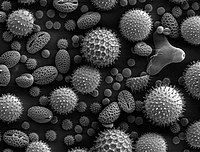
Photo from wikipedia
Objective: To evaluate the clinical efficacy of the combined diagnosis and management in children with airway allergic diseases(bronchial asthma, allergic rhinitis). Methods: This observational study belongs to cluster sampling cases,… Click to show full abstract
Objective: To evaluate the clinical efficacy of the combined diagnosis and management in children with airway allergic diseases(bronchial asthma, allergic rhinitis). Methods: This observational study belongs to cluster sampling cases, which included the clinical data from children with airway allergic diseases in Allergy Department and Otorhinolaryngology Department of Beijing Children's Hospital from April to December in 2015. They were followed up every three months during 12 months. All the subjects were required to continuously record daily symptom by diary card. ACT/c-ACT, VAS, treatment steps to control asthma, respiratory infections, wheeze, pulmonary function(FEV1%pred,FEV1/FVC,PEF%pred,FEF25%pred,FEF50%pred,FEF75%pred,MMEF%pred), FeNO were assessed in every visiting. The mean±standard deviation was used for the measurement data in accordance with normal distribution. Comparing the pulmonary function indexes at every point, the measurement data with normal distribution and uniform variance were analyzed by single factor analysis of variance, and the measurement data with uneven variance were tested by non-parametric rank sum test. Results: Among 147 recruited participants, 106 completed the combined diagnosis and management. The airway allergic diseases control rate was 87.7% at 12 months after the combined diagnosis and management. At every point, the average daily symptom score and VAS score which were significantly lower than at the baseline(H=35.854,P=0.000)[ 1.2(0.7,2.2),0.6(0.2,1.5),0.4(0.1,1.0),0.5(0.1,1.1) vs 2.0(1.0,3.5)],(H=39.559,P=0.000)[2.5(0.5,4.7),2.2(0.3,4.4),1.8(0.2,4.6),1.6(0.3,3.8) vs 6.9(4.1,9.8)]. ACT/c-ACT score at 3, 6, 9, 12 months were significantly higher than at the baseline (H=79.695,P=0.000) [25.0(22.5,27.0),26.0(24.0,27.0),25.0(23.0,27.0),25.0(24.0,27.0) vs 20.0(17.0,22.0)]. FEV1%pred and FEF25%pred at 3, 6 months were significantly higher than at the baseline (F=3.563,P=0.007)(104.7±12.6 vs 96.8±14.5,103.0±10.3 vs 96.8±14.5),(F=2.456,P=0.046)(96.6±22.0 vs 85.0±21.9,93.3±18.0 vs 85.0±21.9). PEF%pred at 3, 6, 9, 12 months after the combined diagnosis and management were significantly higher than at the baseline(F=5.497,P=0.000)(105.1±18.1,101.2±15.3,99.7±17.1,99.8±17.5 vs 90.3±17.8). FeNO at 3, 6, 9, 12 months respectively were no significantly differences at the baseline(F=0.751,P=0.558)(25.7±23.6 vs 30.7±25.6,25.9±16.5 vs 30.7±25.6,27.5±20.2 vs 30.7±25.6,30.6±19.6 vs 30.7±25.6).The respiratory infections rate were 69.8%(74/106),67.0%(71/106),60.4%(64/106),51.9%(55/106) at 3, 6, 9, 12 months respectively. The wheezing rate was 24.5%(26/106),14.2%(15/106),11.3%(12/106),7.5%(8/106) at 3, 6, 9, 12 months respectively. Conclusions: The combined diagnosis and management can significantly improve the control level of children's airway allergic diseases, which should be implemented in the management of children's airway allergic diseases.
Journal Title: Zhonghua yu fang yi xue za zhi [Chinese journal of preventive medicine]
Year Published: 2021
Link to full text (if available)
Share on Social Media: Sign Up to like & get
recommendations!